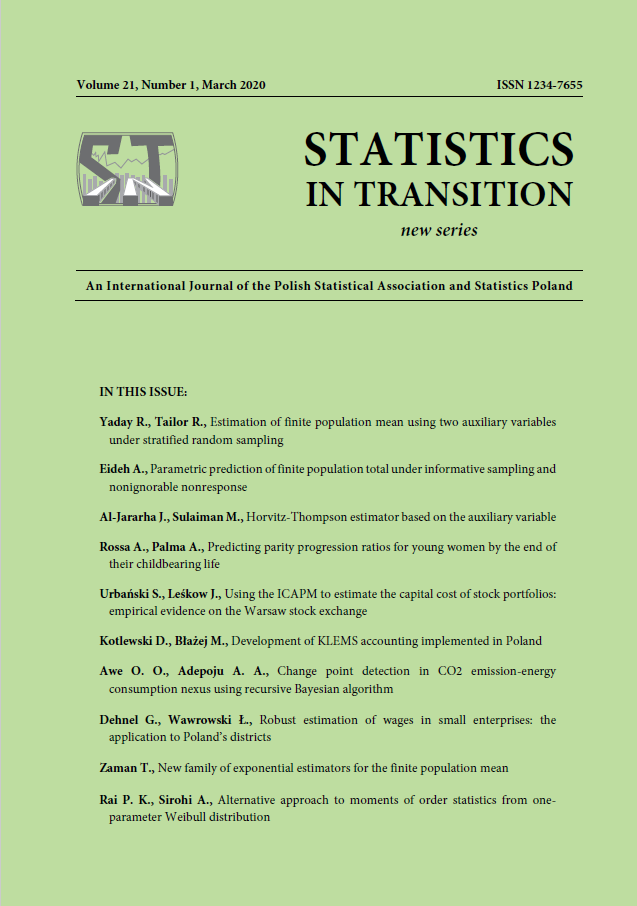ARTICLE
ABSTRACT
The paper presents an empirical study designed to test a small area estimation method. The aim of the study is to apply a robust version of the Fay-Herriot model to the estimation of average wages in the small business sector. Unlike the classical Fay-Herriot model, its robust version makes it possible to meet the assumption of normality of random effects under the presence of outliers. Moreover, the use of this version of the Fay-Herriot model helps to improve the precision of estimates, especially in domains where samples are of small sizes. These alternative models are supplied with auxiliary variables. The study seeks to present the characteristics of and differences among small business units cross-classified by selected NACE sections and district units of the provinces of Mazowieckie and Wielkopolskie. It was carried out on the basis of data from a survey conducted by the Statistical Office in Poznan and from administrative registers. It is the first study which attempts to produce estimates of average wages for this sector of the national economy.
KEYWORDS
small area estimation, indirect estimation, robust Fay-Herriot model, administrative registers, enterprise statistics
JEL
C13, C51, M20
REFERENCES
CHAMBERS, R., TZAVIDIS, N., (2006). M-quantile models for small area estimation, Biometrika, 93(2), pp. 255-268.
CHAMBERS, R., CHANDRA, H., SALVATI, N., TZAVIDIS, N., (2014). Outlier robust small area estimation, Journal of the Royal Statistical Society: Series B (Statistical Methodology), 76(1), pp.47-69.
DEHNEL, G., (2016). M-estimators in business statistics. Statistics in Transition, New Series, 2016, Vol. 17, No. 4, pp. 749-762, ISSN 1234-7655, http://dx.doi.org/10.21307/stattrans- 2016-050.
DEHNEL, G., WAWROWSKI. Ł., (2018). Robust Estimation Of Revenues Of Polish Small Companies By NACE Section And Province, In: M. Papież and S. Śmiech (Eds.), The 12th Professor Aleksander Zeliaś International Conference on Modelling and Forecasting of Socio-Economic Phenomena, Conference Proceedings, Foundation of the Cracow University of Economics, Cracow, pp. 110-119. URL http://dx.doi.org/10.14659/SEMF.2018.01.11.
EUROSTAT, (2013). Handbook on precision requirements and variance estimation for ESS households surveys, European Commission, Belgium, DOI:10.2785/13579.
FAY III, R. E., HERRIOT, R. A., (1979). Estimates of income for small places: an application of James-Stein procedures to census data, Journal of the American Statistical Association, 74(366a), pp. 269-277.
GONZÁLEZ-MANTEIGA, W., LOMBARDIA, M., MOLINA, I., MORALES, D., SANTAMARIA, L., (2008). Analytic and bootstrap approximations of prediction errors under a multivariate Fay-Herriot model. Computational Statistics and Data Analysis, 52(12), pp. 5242-5252, http://EconPapers.repec.org/ RePEc:eee:csdana:v:52:y:2008:i:12:p:5242-5252.
GUADARRAMA, M., MOLINA, I., RAO, J. N. K., (2016). A comparison of small area estimation methods for poverty mapping, Statistics in Transition new series, 1(17), pp. 41-66.
GUS, (2013). Działalność przedsiębiorstw niefinansowych w 2011 r., Zakład Wydawnictw Statystycznych, Warszawa, (Activity of Non-financial Enterprises in 2011), Central Statistical Office of Poland, Warszawa. URL, http://stat.gov.pl/obszary-tematyczne/podmioty-gospodarcze-wynikifinansowe/ przedsiebiorstwa-niefinansowe/dzialalnosc-przedsiebiorstw-niefinansowychw- 2016-r-,2,12.html [Accessed 14 November 2018].
GUS, (2013a). Narodowy Spis Powszechny Ludności i Mieszkań. Ludność. Stan i struktura demograficzno-społeczna, Zakład Wydawnictw Statystycznych, Warszawa, URL http://stat.gov.pl/spisy-powszechne/nsp-2011/nsp-2011-wyniki/ludnosc-stan-i-strukturademograficzno- spoleczna-nsp-2011,16,1.html [Accessed 14 November 2018].
HOAGLIN, D. C., IGLEWICZ, B., TUKEY, J. W., (1986). Performance of some resistant rules for outlier labeling, Journal of the American Statistical Association, 81(396), pp. 991-999.
HORVITZ, D. G., THOMPSON, D. J., (1952). A generalization of sampling without replacement from a finite universe, Journal of the American statistical Association, 47(260), pp.663-685.
LUMLEY, T., (2004). Analysis of complex survey samples, Journal of Statistical Software 9(1): pp.1-19
MOLINA, I., MARHUENDA, Y., (2015). “sae: An R Package for Small Area Estimation”, The R Journal, 7(1), pp. 81-98. https://journal.r-project.org/archive/2015/RJ-2015-007/RJ-2015-007.pdf
MOLINA, I., RAO, J. N. K., (2010). Small area estimation of poverty indicators. Canadian Journal of Statistics, 38(3), pp. 369-385. R Core Team, (2018). R: A language and environment for statistical computing. R Foundation for Statistical Computing, Vienna, Austria.
RAO, J. N. K., MOLINA, I., (2015). Small area estimation, John Wiley & Sons.
SINHA, S. K., RAO, J. N. K., (2009). Robust small area estimation, Canadian Journal of Statistics, 37(3), pp.381-399.
STRUŻYCKI, M., (2004). Małe i średnie przedsiębiorstwa w gospodarce regionu, PWE, Warszawa.
TZAVIDIS, N., ZHANG, L. C., LUNA, A., SCHMID, T., ROJAS-PERILLA, N., (2018). From start to finish: a framework for the production of small area official statistics, Journal of the Royal Statistical Society: Series A (Statistics in Society), 181(4), pp. 927-979.
WARNHOLZ, S., (2016). Small Area Estimation Using Robust Extensions to Area Level Models, Doctoral dissertation, Freie Universität Berlin.
WARNHOLZ, S., (2018). saeRobust: Robust Small Area Estimation. R package version 0.2.0, https://CRAN.R-project.org/package=saeRobust.
WAWROWSKI, Ł., (2016). The Spatial Fay-Herriot Model in Poverty Estimation, Folia Oeconomica Stetinensia, 16(2), pp. 191-202.
